
Rooibos, Aspalathus linearis, is a broom-like member of the plant family Fabaceae that grows in South Africa's fynbos biome.

Aiphanes is a genus of spiny palms which is native to tropical regions of South and Central America and the Caribbean. There are about 26 species in the genus, ranging in size from understorey shrubs with subterranean stems to subcanopy trees as tall as 20 metres (66 ft). Most have pinnately compound leaves ; one species has entire leaves. Stems, leaves and sometimes even the fruit are covered with spines. Plants flower repeatedly over the course of their lifespan and have separate male and female flowers, although these are borne together on the same inflorescence. Although records of pollinators are limited, most species appear to be pollinated by insects. The fruit are eaten by several birds and mammals, including at least two species of amazon parrots.

Aiphanes minima is a spiny palm tree which is native to the insular Caribbean from Hispaniola to Grenada, and widely cultivated elsewhere. Usually 5–8 metres (16–26 ft) tall, it sometimes grows as an understorey tree and only 2 m (6.6 ft) in height.

Aiphanes duquei is a species of palm that is endemic to Colombia. Known from only a small area in the Cordillera Occidental, it is threatened by habitat loss and forest management practices.
Aiphanes hirsuta is a species of flowering plant in the family Arecaceae. It is found in Colombia, Costa Rica, Ecuador, and Panama.
Aiphanes leiostachys is a species of palm that is endemic to Colombia. Known from only a few forest fragments in the Cordillera Central, it is threatened by habitat loss and forest management practices.
Aiphanes lindeniana is a species of palm that is endemic to Colombia. Although widespread in the Cordillera Occidental and Cordillera Central, it is threatened by habitat loss and forest management practices.
Aiphanes ulei is a species of flowering plant in the family Arecaceae. It is found in Brazil, Ecuador, and Peru.
Aiphanes verrucosa is a species of flowering plant in the family Arecaceae. It is found only in Ecuador. Its natural habitat is subtropical or tropical moist montane forests. It is threatened by habitat loss.

The lined quail-dove is a species of bird in the family Columbidae. It is found in Colombia, Trinidad and Tobago, and Venezuela.
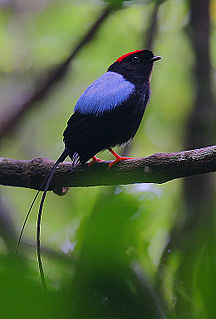
The long-tailed manakin is a species of bird in the family Pipridae native to Central America where it inhabits both wet and dry tropical and subtropical forests. It is a small, plump bird about 10 centimetres (4 in) long. Males have black plumage with a blue back and a red crown, and the two central tail feathers are greatly elongated. Females and juveniles are olive-green with paler underparts. At breeding time, males are involved in a cooperative lekking behaviour with a complex coordinated courtship dance. This is a fairly common species with a wide range, and the International Union for Conservation of Nature has rated its conservation status as being of "least concern".
Macrancylus linearis is a species of terrestrial beetle in family Curculionidae. It is believed to have originated in the Pacific, having been introduced in mainland USA. It is currently distributions includes Hawaii, Texas, Florida and the West Indies. The insect was found along shorelines, specifically in driftwood.
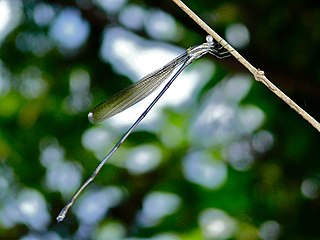
Mecistogaster is a genus of large Neotropical damselflies in the family Pseudostigmatidae, commonly known as helicopter damsels. There are eleven species distributed from Mexico to Argentina.
Myrsine knudsenii, the Kokee colicwood, is a species of tree in the primrose family. It is endemic to the island of Kauai in Hawaii. It is threatened by habitat loss.
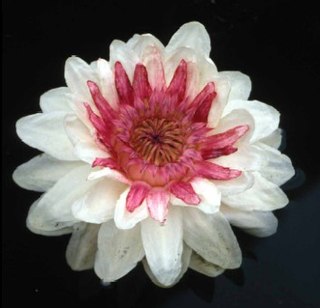
The Flora of Colombia is characterized by over 28,000 species of green plants.

Persoonia linearis, commonly known as the narrow-leaved geebung, is a shrub native to New South Wales and Victoria in eastern Australia. It reaches 3 m (9.8 ft), or occasionally 5 m (16 ft), in height and has thick, dark grey papery bark. The leaves are, as the species name suggests, more or less linear in shape, and are up to 9 cm (3.5 in) long, and 0.1 to 0.7 cm wide. The small yellow flowers appear in summer, autumn and early winter, followed by small green fleshy fruit known as drupes. Within the genus Persoonia, it is a member of the Lanceolata group of 58 closely related species. P. linearis interbreeds with several other species where they grow together.
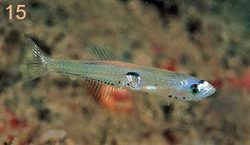
Crystallogobius linearis, the crystal goby, is a species of goby native to the Atlantic coasts of Europe and the Mediterranean Sea where it can be found at depths of from 1 to 400 metres. Males of this species grow to a length of 4.7 centimetres (1.9 in) SL while females only reach 3.9 centimetres (1.5 in) SL. This species is the only known member of its genus. The name Crystallogobius comes from the Latin words cristallum, meaning "crystal", and gobius, meaning gudgeon.
Pyractomena linearis is a species of firefly in the beetle family Lampyridae. It is found in North America.
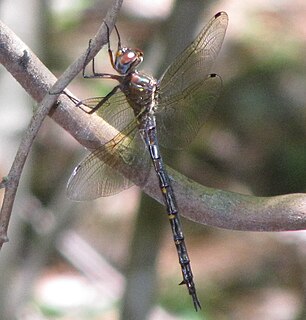
Somatochlora linearis, the mocha emerald, is a species of emerald dragonfly in the family Corduliidae. It is found in North America.











